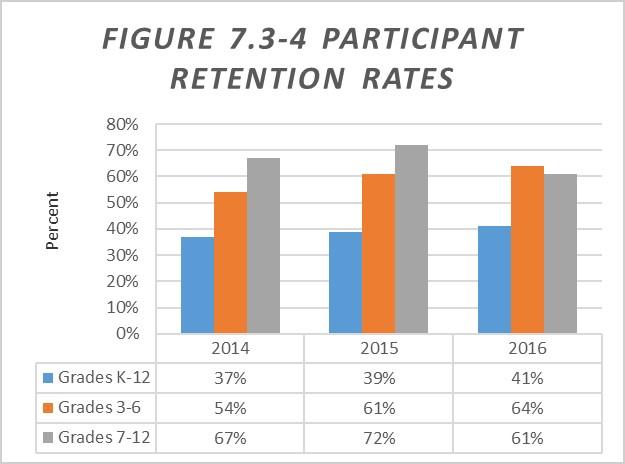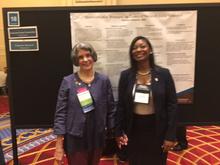Blogrige
The Official Baldrige Blog
Where Business Students Use the Baldrige Framework to Solve Real-World Problems

Data from Dr. Tammy Jameson's research; used with permission.
When Tamieka Jameson graduated with her doctorate in business administration (DBA) recently, she also celebrated the completion of a consulting capstone in which she helped a nonprofit organization address a strategic challenge it was facing. Jameson used the Baldrige Excellence Framework as a key resource for her research and recommendations to help the organization. Jameson is the first student to complete a new Baldrige framework-based capstone option within the DBA program of Walden University, an accredited university that is headquartered in Minneapolis, MN.
The consulting capstone that Jameson helped pilot for Walden’s online doctoral program was designed to provide her with direct experience in guiding a nonprofit organization to solve a key business problem by applying the core concepts and Criteria for Performance Excellence of the Baldrige framework. Jameson’s capstone project focused on how to improve processes and results to support both the short- and long-term success of the organization.
In a recent interview for this blog, Jameson told me she was chosen for the pilot based on her scholarship and commitment to bringing about positive social change in the business and nonprofit sectors. Prior to enrolling, Jameson had worked for four years as a contractor for a U.S. military organization based in the Washington, D.C., area. She had previously been enrolled in another doctoral program, which she did not complete, but many of her credits transferred. She continued working full-time while taking four additional classes online and conducting her capstone research in the Walden program.

In describing the educational experience, Jameson stressed the dual roles she played: “I served as both a researcher and a consultant, whereas most students in doctoral programs would serve just as researchers,” she said, clarifying that she was not paid as a student. “Participating in Walden’s DBA Consulting Capstone helped groom me for what was beyond graduation.”
The Research Experience
Jameson conducted her capstone project within a 40-week timeline set by the college. Among criteria for interested organizations to voluntarily participate in the consulting capstone program, they must be in business for at least five years. Jameson was assigned to a small nonprofit that supports youth performance arts within a mid-western city.
“The founder is passionate about social change—that drives everything she does,” said Jameson in describing the appeal of the organization to her as a researcher. Located within a community with many other arts organizations, Jameson’s client/research subject faced the challenge of “competing for the same donors.”
Jameson used the Baldrige Criteria for Performance Excellence as a foundation to guide her research. “I embedded my research questions in all seven categories of the Criteria for Performance Excellence,” she said. “What I love the most about the Criteria is category 7,” she added.
“Up to that point, I felt like I was just collecting information. But when I got to category 7, it was like a big ‘aha’ moment.” For example, she said the results data she compiled on the organization’s participant retention rates (shown in the graphic below) indicate the effectiveness of senior leaders' processes to leverage the organization's core competency to attract and retain key stakeholders.
According to Jameson, senior leaders’ process effectiveness is demonstrated through increased student retention rates over a recent three-year period. As participants become engaged in the overall instructional program, they tend to remain enrolled and meet achievement goals, she noted. In compiling results to help the organization better understand its performance, Jameson said she “conducted data comparisons for both my client organization and its competitors.” When her client organization did not have data she sought, she was able to use online resources to fill in gaps.
Jameson also described the collaborative way in which she proceeded in drafting her capstone report: “Along the way, as I would draft a section, I would let the organization review it to make sure what I captured was accurate,” she said. “Then when I completed the draft, I shared it with the organization for another review.”
Support from a Baldrige Mentor
Jameson stressed that she benefited greatly from the support of the Walden faculty member who chaired her doctoral research, Dr. Jan Garfield. Garfield has been an active volunteer for many years at the national and state levels as a Baldrige examiner. She also served for more than three years as the chair of the board of directors for the U.S. Senate Productivity and Quality Award, a Baldrige-based program serving organizations in Virginia and Washington, D.C.

As Jameson’s mentor in the Walden program, Garfield provided support through weekly phone calls and “constant emails,” Jameson recalled. “She guided me through the Baldrige framework and helped connect the dots in my understanding.” “I’ve learned so much from her and am so appreciative for this opportunity,” Jameson continued. “She went way beyond the call of duty—I don’t think I would get that anywhere else.”
Garfield shared, “It was a learning journey for Tamieka and her client organization, and it was transformative. They emerged from that experience as completely different leaders in their respective roles due to the power of the Baldrige framework.” Speaking of Jameson, Garfield said, “Watching her evolve and guide her client organization was amazing.”
She added, “The Baldrige Criteria’s systems perspective is a powerful tool in the hands of doctorally trained professionals. One of the things they see is that the framework is going to help them analyze the connective tissue of an organization. When students in the Walden DBA consulting capstone are asked to explore a business problem [of an organization], they find they must look at all areas of performance. The framework gives them insight into how leaders think within a systems perspective—or not.”
Findings for Future Improvement
The recommendations Jameson provided in her capstone project focus on strategies for the arts organization to better retain donors through improved communications. “If an organization constantly lets donors know what it’s doing in the community, the donor knows where its money is going and is more likely to keep giving,” Jameson pointed out.
“My client organization was doing this already, but I helped senior leaders identify the need for lessons-learned processes. I was able to help senior leaders formalize organizational processes to identify additional communication strategies to retain donors and attract new donors.”
A final version of Jameson’s report with all her recommendations was printed at the beginning of the summer, and the organization received it before her graduation. “Nothing included in my study will be a surprise to the organization,” said Jameson, “because we’ve already discussed everything. I was very transparent throughout the process.”
Other Graduate Programs Using the Baldrige Framework
In making the Baldrige Excellence Framework a basis for DBA students’ new consulting capstone option, Walden University joins a number of institutions around the country that have seen value in teaching the Baldrige framework to the nation’s future business and other organizational leaders.
A 2014 blog post on incorporating study of the Baldrige framework in collegiate programs noted as examples Creighton University’s online interdisciplinary doctorate program on leadership; Post University’s bachelor of science degree programs in the Malcolm Baldrige School of Business (in Waterbury, CT); and the University of Cincinnati’s master’s degree in health administration (within its business college).
Following are four more examples of ways that graduate degree programs in business and health care administration (listed in alphabetical order) are currently using the Baldrige framework as a key resource or focus for studies:
1. Evangel University in Columbia, MO: The master’s degree program in organizational leadership “is aligned with the Baldrige Model for assessing effective organizations,” with “courses addressing each of the components,” according to the description online. Students “complete and present projects related to their organizations with high potential for making improvements within them.”
For instance, a course description for “The Effective Organization” states that it includes “examination of the Baldrige National Quality Program's Criteria for Performance Excellence and how it is used to assess and improve organizational performance” and that “students will identify an organization for applied research and a mentor within the corporation who will assist them in obtaining access to the information needed to complete the assignment.”
2. Ferris University in Big Rapids, MI: The master’s degree program in business administration studies the Baldrige framework, as referenced in course descriptions such as “Introduction to Performance Metric Systems” (which covers “the interrelationship between the Balanced Scorecard and Baldrige Performance Excellence Program Criteria as performance metric systems”) and “Customer and Market Systems and Analysis” (which explores “Category 3 of the Baldrige Performance Excellence Program Criteria”).
3. The University of Missouri’s Missouri Training Institute in Columbia, MO, notes that its course on the Baldrige Criteria for Performance Excellence is “applicable to all organizations regardless of size or mission.” The description states, “The Baldrige Criteria for Performance Excellence is the recognized standard for creating world-class organizations. The Criteria has been successfully implemented by for-profit, not-for-profit, government, educational and health care organizations.” The class covers Baldrige success stories, the Criteria’s system perspective, the Criteria’s core values, and interpreting the Criteria, among other topics of study.
Readers: If you are teaching about or otherwise using the Baldrige framework in your education institution or other work, please share your story with us! Please note that our purpose is to provide examples of how the Baldrige Excellence Framework can be used to help organizations of any sector and size strengthen performance for long-term success; no endorsement of any organization or its services or products is implied.
About the author
Related Posts
Comments
- Reply





